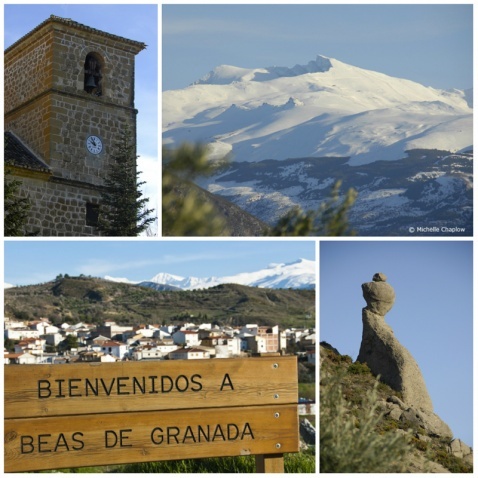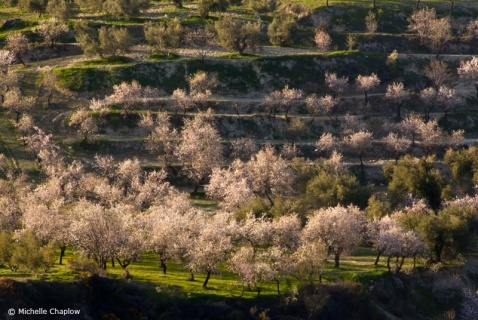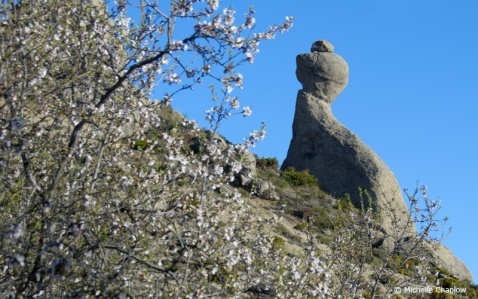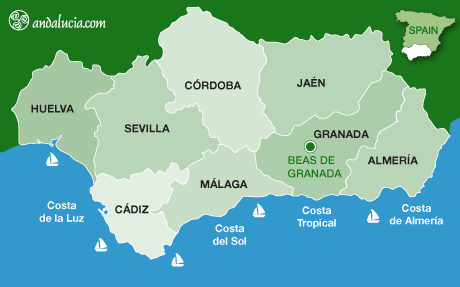
Photos - Clockwise. Iglesia Parroquial de la Inmaculada. Great views of the snow capped Sierra Nevada Mountains. The village. The stone monument, El Fraile. ( Click to enlarge). |
|

Springtime in Beas de Granada. Almond trees, farmed for hundreds of years on the terraced landscape of Beas de Granada, Sierra de Huétor © Michelle Chaplow |
|

According to a ledgend, in Moorish times treasure was burried in the Sierra de Huétor, this is one of two stautes that appaerntly leads to the treasure. © Michelle Chaplow |
|
Beas de Granada is known for its legend, which still attracts treasure seekers to the town. It is said that a wealthy Arab merchant hid his fortune to protect it when the Catholic Monarchs were fighting for the reconquest of Granada. The story goes that he hid his wealth in one of two identical statues, one was torn down in search of the treasure. The other legendary statue, El Fraile (The Friar), a natural rock formation in the Cerro Del Fraile (Friar’s Hill) sculptured by wind erosion, remains and which is now a popular tourist site. It has approximately 1000 residents.
History
Beas de Granada’s origin dates back to the time of the Roman Empire. The oldest documentary references place it on the Roman road to Acci (modern-day Guadix). The name is believed to come from the Latin word Viax, meaning road. It originated as a post house or a place of supply and rest located at a crossroads, making it strategically important during the Roman era as it was located on the required passage for travellers and for military or commercial actions. During the Arab era, it became a fortified rural community with approximately twenty families living around a central fortress. Unfortunately, today there are no physical remains of that fortress. The settlers engaged in non-irrigated agriculture and cultivated mulberry trees to support Granada's silk industry. After the Reconquista, the lands and houses of this municipality were divided between Francisco de Bobadilla y Maldonado (15th century nobleman) and the Moors. However, heavy taxes were levied on the residents, forcing them to revolt, resulting in them being expelled. During the revolt, part of the church was burned down. The municipality was repopulated with settlers from Castile, León, Asturias, and Galicia.
Things to See
Iglesia Parroquial de la Inmaculada Concepción
The Iglesia Parroquial de la Inmaculada Concepción (Parish church of the Immaculate
Conception) was originally built between 1530 and 1540 but was sacked and burned by the
Moors during their tax revolt, leaving only the tower standing. It was rebuilt in 1645, following
the Mudejar model of the original church, but poor construction led to its collapse years before
the Spanish Civil War (1936-1939). It was rebuilt for the second time in 1948 around the
original tower, with stones from the remains of the Arab fortress, explaining the lack of ruins
today. Inside, it has a rectangular floor plan with a single nave covered by a truss with masonry
walls. Located in Plaza Iglesia.
Things to see outside town
Molino de Félix
One of the traditional uses of the Río Darro (Darro River) in the province of Granada has been
the use of water to power the different types of mills along the banks of the river. Multiple mills
for various products were established along its bank. The Molino de Félix (Felix’s Mill) was
built to grind cereals, while others were used to unravel woollen cloth or produce paper. Some of
the original mills have deteriorated and are not in use, while others have been restored, with
some used as houses. Located west of the town.
Cortijo de Belén
The owners of Cortijo de Belén (Belén’s Farm) were known as the Señoricos de Belén. They
were renowned for their cultivation, generosity, and nobility. Despite the farm being isolated and
far from the capital, the family had their own chapel, oil mill, and a sweet factory. This farm
gave work to many local people during difficult and harsh times. The chapel was visited many
times by the people of Beas. Despite the distance, the pilgrims, who often travelled by foot or
with their animals, came with a deep devotion to this remote church located amongst large olive
groves and oak trees. Located opposite the Prado de Santa Ana (St Ana’s Meadow), a beautiful
valley of hazelnut trees.
Natural Areas
Sierra de Huétor Natural Park
Designated as a natural park in 1989, the 12,128ha Sierra de Huétor is only a few kilometres
northeast of the provincial capital of Granada, so it is a popular weekend destination for city
dwellers. The mountainous area has dramatic geological features characteristic of limestone
areas, with narrow ravines, steep cliffs, springs, and caves, such as the Cueva del Agua (Water
Cave). The most famous spring is the Fuente Grande (Fountain of Tears) or Aynadamar,
according to the Arabic terminology, in Alfácar. The Moors cleverly used the spring as a source
of water for the Albaicín town in Granada, transported via an irrigation channel.
Bus Service
There is a bus service from Beas de Granada to Granada City.More>
Gastronomy
Beas de Granada has quite the extensive selection of local dishes to try, including ensaladas de judías blancas (white bean salad), potajes de garbanzos y trigo (chickpea and wheat stew), costillas de cerdo con setas (pork ribs stewed with wild ceps), chuletas de cordero (lamb chops), granadinas de vaca y rodillos de ternera (beef stew) and ajoblanco (chilled garlic and almond soup). Sweet treats include tarta de manzana (apple pie), tarta de almendras (almond tort), leche frita (fried custard), roscos de huevo (doughnuts) and flan con bizcocho (egg custard with spongecake). The star product in Beas de Granada is “mosto”, a grape beverage that accompanies many of the hearty stews and meat dishes.
Festivals
Popular festivals in Beas de Granada are Fiestas de San Roque (Festivals of San Roque), Semana Santa (Holy Week), Rosario de la Aurora (Rosary of the Dawn), Romería del Santo Almecí (Pilgrimage of St Almecí), Romería de la Virgen del Pilar (Pilgrimage of the Virgin of Pilar), and Día de la Cruz (Day of the Cross). More>
Weather Forecast
The weather forecast for the next few days for Beas de Granada. More>
Nearby Places
The neighbouring villages to Beas de Granada are Villanueva del Arzobispo and Arroyo del Ojanco.
Bus Services
There is a bus service from Beas de Granada to Granada City using the local bus company.
The bus stop in Beas de Granada is in Plaza Alta.
Check the timetables here.
